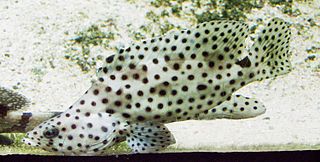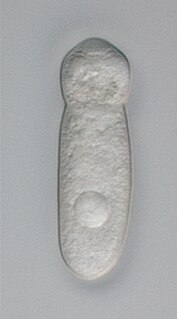Related Research Articles

The Apicomplexa are a large phylum of parasitic alveolates. Most of them possess a unique form of organelle that comprises a type of non-photosynthetic plastid called an apicoplast, and an apical complex structure. The organelle is an adaptation that the apicomplexan applies in penetration of a host cell.

The Serranidae are a large family of fishes belonging to the order Perciformes. The family contains about 450 species in 65 genera, including the sea basses and the groupers. Although many species are small, in some cases less than 10 cm (3.9 in), the giant grouper is one of the largest bony fishes in the world, growing to 2.7 m in length and 400 kg (880 lb) in weight. Representatives of this group live in tropical and subtropical seas worldwide.

Groupers are fish of any of a number of genera in the subfamily Epinephelinae of the family Serranidae, in the order Perciformes.

The gregarines are a group of Apicomplexan alveolates, classified as the Gregarinasina or Gregarinia. The large parasites inhabit the intestines of many invertebrates. They are not found in any vertebrates. However, gregarines are closely related to both Toxoplasma and Plasmodium, which cause toxoplasmosis and malaria, respectively. Both protists use protein complexes similar to those that are formed by the gregarines for gliding motility and invading target cells. This makes them excellent models for studying gliding motility with the goal of developing treatment options for toxoplasmosis and malaria. Thousands of different species of gregarines are expected to be found in insects, and 99% of these gregarines still need to be described. Each insect can be the host of multiple species. One of the most studied gregarines is Gregarina garnhami. In general, gregarines are regarded as very successful parasites, as their hosts are spread over the entire planet.

The Streblidae are a family of flies in the superfamily Hippoboscoidea, and together with their relatives the Nycteribiidae, are known as bat flies. They are winged or wingless ectoparasites of bats, and often have long legs. They appear to be host-specific, with different species of bat flies occurring only on particular species of bat hosts, sometimes with multiple species of flies sharing a host bat.

Odostomiinae, Odostomia snails and their allies, is a taxonomic subfamily of minute parasitic sea snails. These are marine heterobranch gastropod mollusks, or micromollusks, in the family Pyramidellidae.

Palaemonidae is a family of shrimp in the order Decapoda. Many species are carnivores that eat small invertebrates, and can be found in any aquatic habitat except the deep sea. One significant genus is Macrobrachium, which contains commercially fished species. Others inhabit coral reefs, where they associate with certain invertebrates, such as sponges, cnidarians, mollusks, and echinoderms, as cleaner shrimps, parasites, or commensals. They generally feed on detritus, though some are carnivores and hunt tiny animals.

Lutjanidae, or snappers are a family of perciform fish, mainly marine, but with some members inhabiting estuaries, feeding in fresh water. The family includes about 113 species. Some are important food fish. One of the best known is the red snapper.

The Haemosporida are an order of intraerythrocytic parasitic alveolates.
The Neogregarinorida are an order of parasitic alveolates in the phylum Apicomplexa. Species in this order infect insects and are usually found in the fat body, hemolymph, hypodermis, intestine or Malpighian tubules. The most common site of infection is the fat body: many species are pathogenic for their hosts.
The Eugregarinorida are the most large and diverse order of gregarines — parasitic protists belonging to the phylum Apicomplexa. Eugregarines are found in marine, freshwater and terrestrial habitats. These species possess large trophozoites that are significantly different in morphology and behavior from the sporozoites. This taxon contains most of the known gregarine species.
The Aikinetocystidae are a family of parasitic alveolates in the phylum Apicomplexa. The species in this family infect oligochaetes.
Aseptatorina is a suborder of parasitic alveolates of the phylum Apicomplexia
Allantocystis is a genus in the family Allantocystidae. Its only species is Allantocystis dasyhelei, a gregarine parasite of the larval biting midge Dasyhelea obscura.
The Selenidiidae are a family of parasitic alveolates in the phylum Apicomplexa.
The Monocystinae are a subfamily of parasitic alveolates in the phylum Apicomplexa.
The Rhynchocystinae are a subfamily of parasites in the phylum Apicomplexa.
The Stomatophorinae are a subfamily of parasites in the phylum Apicomplexa.
Nematopsis (Nee-mah-top-cis) is a genus gregarine Apicomplexan of the family Porosporidae. It is an aquatic parasite of crustaceans with a molluscan intermediate host. Nematopsis has been distinguished from the similar genus Porospora by its resistant and encapsulated oocyst. Little molecular biology has been performed on the members of the Nemaptosis and species are described based on molluscan and crustacean hosts as well as oocyst structure. A total of 38 species have been described and are found all over the world.

Gregarina garnhami is a eukaryotic unicellular organism belonging to the Apicomplexa described in 1956 by Canning as a parasite found in several locusts, such as the desert locust, African migratory locust, and Egyptian locust. Especially, the desert locust is the host for this species, as up to 100% of animals can become infected. An estimated thousands of different species of gregarines can be in insects and 99% of these gregarines still need to be described. Each insect is said to host multiple species. A remarkable feature of G. garnhami is its autofluorescence.
References
- ↑ Ormières, R. (1977). "Deux nouvelles espèces de Grégarines parasites d'Annélides : Pleurocystis eiseniellae d'Eiseniella tetraedra Sav. (Oligochète), Pterospora petaloprocti de Petaloproctus terricola Quatr. (Polychète)". Annales de Parasitologie Humaine et Comparée. 52 (2): 109–116. doi: 10.1051/parasite/1977522109 .

- ↑ Bhatia, B. L. (1930). "Synopsis of the Genera and Classification of Haplocyte Gregarines". Parasitology. 22 (2): 156–167. doi:10.1017/S0031182000011033. ISSN 0031-1820. S2CID 85701216.